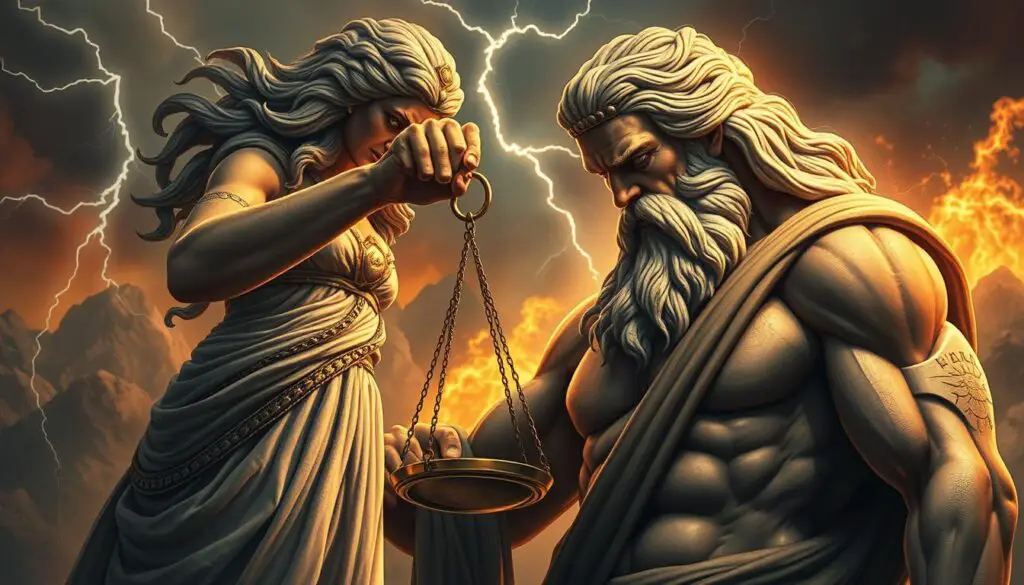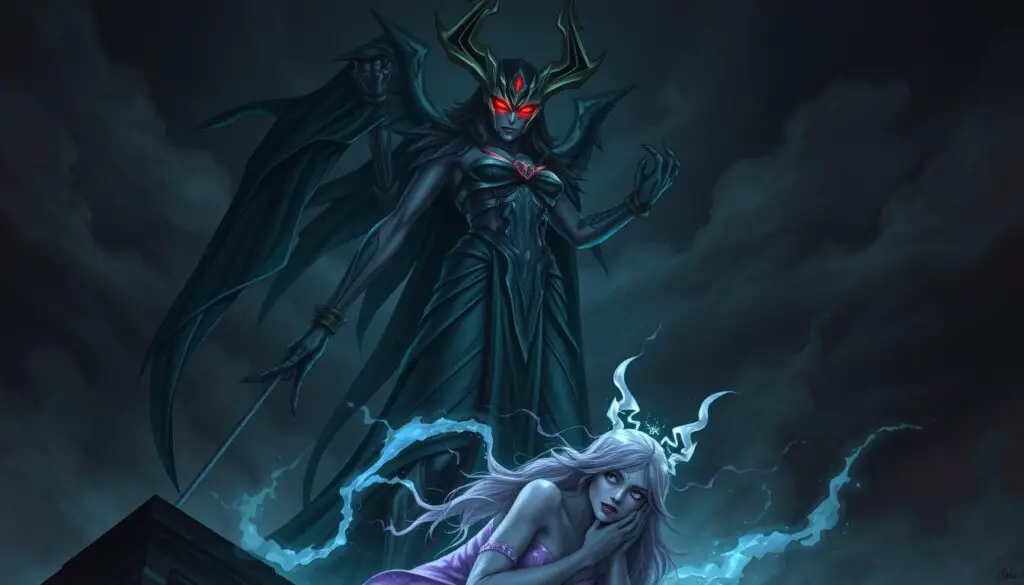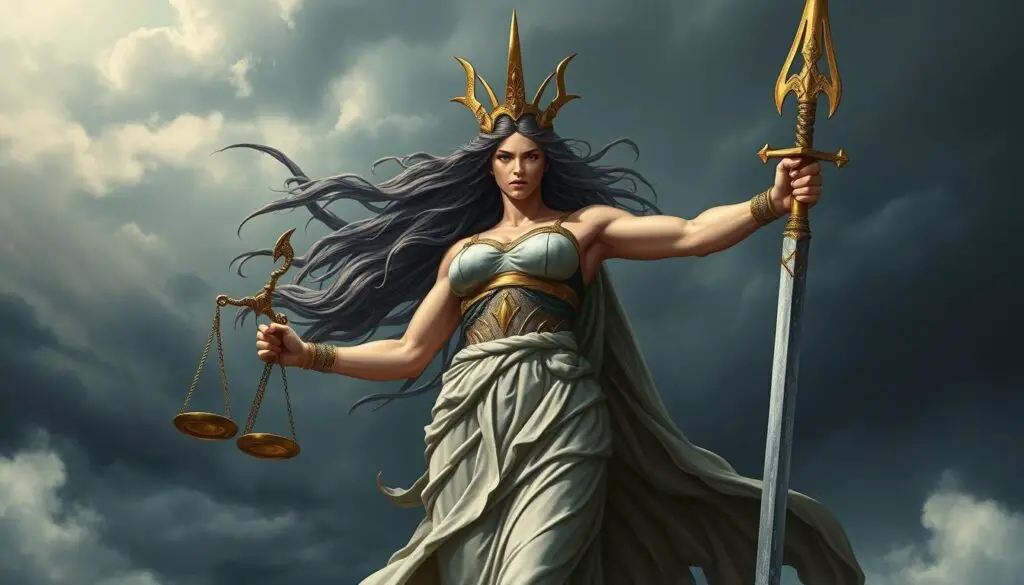Nemesis, a key figure in Greek mythology, embodies the concept of divine retribution and balance.
Known as the Nemesis deity, she ensured justice by punishing those who exhibited hubris, or excessive pride before the gods.
As a vengeance goddess, Nemesis maintained cosmic equilibrium, her influence extending across ancient religious practice and myth.
Her roots trace back to the Proto-Indo-European term “nem-,” meaning “to distribute,” underlining her role in the dispensation of fate and vengeance.
The importance of Nemesis in Greek mythology cannot be overstated.
Associated with goddesses like Themis and Dike, Nemesis was integral to sustaining moral order and holding offenders accountable.
Revered in the ancient sanctuary of Rhamnous in Attica, she was also known as the “Goddess of Rhamnous,” a testament to her lasting impact on Greek cultural and religious landscapes.
Key Takeaways
- Nemesis ensured justice by punishing hubris before the gods.
- The name Nemesis comes from “nem-,” meaning “to distribute.”
- She was associated with Themis and Dike in maintaining cosmic balance.
- Known as the “Goddess of Rhamnous,” she was worshipped in an important sanctuary.
- Nemesis’ role spanned across mythological tales, enforcing divine retribution.
Introduction to Nemesis, the Greek Goddess of Retribution
Nemesis, often depicted as a winged goddess, holds a significant position in Greek mythology.
She is renowned for embodying the divine response to human arrogance and ensuring a balance of fortune and retribution.
Delving into the Nemesis origin and the etymology of Nemesis unveils her profound influence on ancient cultural and moral frameworks.
Origins and Meaning of the Name Nemesis
The name Nemesis is derived from the Greek word νέμειν, meaning “to give what is due”.
This etymology of Nemesis reflects her role in delivering just retribution and maintaining equilibrium.
In Hesiod’s Theogony, she’s described as the daughter of Nyx, although other traditions mention Erebus, Zeus, or Oceanus as her parents.
Her portrayal evolved, from resembling Aphrodite to a solemn figure holding scales and a sword, signifying her transition to a symbol of divine justice.
Why Nemesis is Important in Greek Mythology
The significance of Nemesis in Greek mythology cannot be overstated.
She represents the personification of moral reverence for law and conscience, often paired with figures like Shame (Aidôs).
The Greeks venerated her, seeing her as a crucial entity in rectifying excesses of fortune, and thus, restoring rightful balance.
Nemesis ensured that any disruption in proportion was corrected, a belief rooted in the idea that gods envied excessive human happiness.
Her story, including the punishment of Narcissus for his vanity, showcases her as an avenging power upholding virtue and deterring hubris.
Nemesis: Goddess of Divine Justice and Retribution
Nemesis, known for her role in Greek mythology as the goddess of retribution, was a powerful force in maintaining balance in the universe.
Acting as the enforcer of cosmic justice, Nemesis ensured that individuals, whether mortal or divine, received their just deserts.
Her presence is a testament to the idea that no act of hubris goes unpunished, and she stands as a guardian against excessive pride and misdeeds.
Role of Nemesis in Dispensing Justice
Nemesis operated as the embodiment of divine justice, meting out retribution to those who committed egregious acts of arrogance.
With her incredible ability to detect and respond to hubris, she maintained cosmic order. Her interventions often involved balancing outcomes, and delivering proportionate consequences to actions.
As the goddess of retribution, Nemesis played a critical role in exacting vengeance and rewarding virtue, a function celebrated and feared in equal measure.
Connection to Divine Justice and Punishment
Within the pantheon of Greek deities, Nemesis’s connection to divine justice was unparalleled.
Those who faced her wrath could expect a relentless pursuit and eventual downfall.
Such is evident in myths like that of Narcissus, where Nemesis administered the ultimate punishment of hubris.
Her constant vigilance ensured that divine justice prevailed, resonating through every tale of moral consequences in ancient lore.
The Family and Lineage of Nemesis
Nemesis, the revered Greek goddess of retribution, has a rich and intricate familial background that contributes significantly to the Greek goddess family tree.
Her origins vary across different mythological sources, presenting diverse possibilities about her lineage.
Parents: Nyx and Erebus
A prominent version of the Nemesis lineage traces her parentage to Nyx, the embodiment of night, and Erebus, the personification of darkness.
This connection places Nemesis among a powerful array of siblings including Thanatos, the Grim Reaper, and Hypnos, the personification of sleep.
The union of these primordial deities emphasizes the mystic and dark nature of Nemesis.
Alternate Lineages: Oceanus and Zeus
Another variant in the Greek goddess family tree links Nemesis to Oceanus, the Titan god of the ocean, highlighting an alternate lineage deeply tied to the vast and enigmatic sea.
Other accounts even describe Nemesis as the offspring of Zeus, the king of the gods, which aligns her with the most powerful figures in Greek mythology.
Offspring of Nemesis
The children of Nemesis are as fascinating and varied as her origins. She is famously tied to the conception of Helen of Troy, the most beautiful woman in Greek mythology whose abduction led to the Trojan War.
Additionally, Nemesis is sometimes credited with mothering the Telchines, magical beings from Rhodes.
These different accounts of the children of Nemesis enrich her mythological narrative, portraying her as a central figure in numerous pivotal Greek myths.
Nemesis in Greek Mythology and Tragedy

Nemesis, the Greek goddess of retribution, played a significant role in various myths and Greek tragedies.
Her presence was a reminder of the inevitability of divine justice and the delicate balance between good and evil.
Nemesis as a Central Figure in Greek Tragedies
In many Greek tragedies, Nemesis appears as a force ensuring that those who commit moral transgressions are duly punished.
This concept ties closely with her role in retribution, where she serves as a counterbalance to hubris, reminding mortals of their place in the cosmos.
A prime example is the story involving Narcissus, where Nemesis mythology showcases her punishing the prideful Narcissus by making him fall in love with his reflection, ultimately leading to his tragic end.
Nemesis in Myths and Legends
Beyond Greek tragedies, Nemesis is featured prominently in various myths.
One notable myth is her involvement in the conception of Helen of Troy.
According to legends, Nemesis took the form of a swan and mated with Zeus, leading to the birth of Helen, a central figure in causing the Trojan War.
This story highlights the profound influence of Nemesis mythology in shaping the larger narrative arcs of Greek myths.
Other myths featuring Nemesis often revolve around themes of retribution and balance, ensuring that reparation follows all acts of arrogance toward the gods.
Who Was Nemesis?
Nemesis, often known as the incarnation of divine retribution, played a crucial role in Greek mythology.
Her functions transcended from being just a deity who balanced justice to embodying the personification of revenge.
This shift ensured societal adherence to humility and fairness and showcased the severe repercussions of pride and arrogance.
Understanding Her Role as the Personification of Revenge
In essence, the evolution of the Nemesis Greek goddess role signified her progression from a mere enforcer of equity to the ultimate avenger against human misdeeds.
Nemesis’ pursuit of justice was not just confined to punishing trivial sins but focused particularly on vendetta against those who succumbed to excessive arrogance.
Aligning her divine vigilante actions with hubris in Greek mythology, Nemesis ensured that no act of impiety remained unpunished.
Nemesis and the Concept of Hubris
The concept of hubris in Greek mythology is deeply intertwined with the Nemesis Greek goddess role.
Hubris, typically described as extreme pride or self-confidence, was considered an offense to the gods. Nemesis was the divine force ensuring that such defiant overreach was met with appropriate punishment.
Her embodiment as the personification of revenge reminded mortals of the indispensability of humility and the inevitability of divine retribution for their transgressions.
Iconography and Symbols of Nemesis
The iconography of Nemesis, the Greek goddess renowned for her role in retribution, is rich and varied.
Often depicted as a majestic, winged figure, her imagery encapsulates the essence of swift and inevitable divine justice.
These wings are a significant part of the “Nemesis symbols”, embodying her role in swiftly delivering punishment to those deserving.
The Winged Goddess
Narratives regularly illustrate Nemesis as a winged goddess, emphasizing her capacity to deliver justice speedily.
Her wings represent not just physical swiftness, but also the inescapability of retribution.
In some artistic portrayals, she is seen riding a chariot drawn by griffins, further signifying her formidable and relentless nature.
Attributes: Sword, Scales, and Bridle
Several “Greek goddess attributes” are consistently associated with Nemesis, each symbolizing her various roles and the nature of justice she dispenses.
The sword signifies punishment, ready to strike those who succumb to hubris.
The scales, a universal symbol of balance, depict her duty in maintaining cosmic equilibrium.
The bridle, less commonly seen but equally significant, implies the restraint and measure needed to prevent individuals from overstepping their bounds.
These *Nemesis symbols* have remained influential through centuries, mirrored in various pieces of art and literature.
Her authority in maintaining order within the universe is continually echoed through these powerful icons, ensuring that her revered position in Greek mythology endures.
Nemesis in Art and Literature
The concept of Nemesis has been a significant source of inspiration for numerous artists and writers.
Her presence in both art and literature not only emphasized her importance but also served to maintain the balance of justice within human and divine realms.
Well-crafted nemesis characters are essential for creating conflict, character development, and enhancing the drama in literature.
Depictions in Ancient Art
Nemesis in art is vividly represented through various ancient frescoes and sculptures, often showcasing her symbolic attributes such as the sword, scales, and bridle.
These ancient depictions of Greek gods, particularly Nemesis, highlight her role as the bringer of justice and retribution.
The artistic portrayal of Nemesis typically included wings, symbolizing her swift justice.
Due to her association with balance and fairness, she was frequently shown holding scales.
This iconography has inspired countless artists throughout history to capture the essence of divine justice.
Nemesis in Literary Works
In literature, Nemesis is a prevalent device representing opposition and challenge.
Such representation in literature serves as the protagonist’s primary source of adversity, propelling the narrative forward.
Historical works by poets like Mesomedes often featured Nemesis as a key figure, underscoring her role in themes of justice, revenge, and the consequences of actions.
This literary tradition continued through various forms of storytelling, including modern novels, poetry, children’s literature, and even songs.
The nemesis character is central to many renowned stories like “Sherlock Holmes,” “Moby-Dick,” and the “Harry Potter” series, where they drive plot development and thematic exploration through conflict and rivalry.
Nemesis and Zeus: The Unusual Tale

The tale of Nemesis and Zeus is one of the most peculiar in Greek mythology, illustrating the complex relationships between gods and their transformative powers.
The Pursuit of Nemesis by Zeus
Zeus, the ruler of Mount Olympus, became infatuated with Nemesis, the goddess of divine retribution.
This infatuation led to a relentless pursuit where Zeus’ pursuit showcased his determination and unwavering desire.
Nemesis, known for her ability to dispense justice and her elusive nature, transformed herself multiple times to evade Zeus.
She shifted into various animals, including a fish, a bird, and even a serpent, in an attempt to escape his advances.
The Birth of Helen of Troy
Ultimately, the birth of Helen of Troy was a direct consequence of this tumultuous chase.
To escape from Zeus’ pursuit once more, Nemesis transforms into a goose.
Undeterred, Zeus turned himself into a swan and caught Nemesis, resulting in an egg that would eventually be given to Leda.
From this egg, Helen of Troy was born, a character famously known for her role in the Trojan War.
Nemesis and the Story of Narcissus
The tale of Narcissus is one of the most enduring myths, rooted deeply in the themes of vanity and divine retribution.
Nemesis, the Greek goddess of retribution, plays a pivotal role in this narrative.
Her intervention in the Narcissus myth showcases the consequences of excessive pride and the inevitable fall that follows.
Nemesis’ Role in the Narcissus Myth
Nemesis, known for delivering divine justice, becomes a key player due to the actions of Narcissus.
This hunter, recognized across Greek mythology for his extraordinary beauty, seized attention wherever he went.
However, his vanity and pride led him to spurn many admirers, eliciting feelings of deep hurt and rejection.
The most notable intervention of Nemesis in the myth occurs through Ameinias, a young man cruelly dismissed by Narcissus.
Pleading with the goddess of revenge, Ameinias’ suffering prompts Nemesis to curse Narcissus, ensuring he would never attain the love he so desired.
Thus, the curse steers Narcissus to fall hopelessly in love with his reflection, a poignant example of Nemesis’ revenge.
Consequences of Vanity and Pride
The dark allure of Narcissus’ reflection epitomizes the dangers of excessive self-love and arrogance within mythology.
His fixation on his image ultimately leads to his demise, whether through wasting away or by death, transforming into the narcissus flower.
This ending serves as a mortal reminder of the perilous consequences of vanity and pride in mythology.
Echo, the nymph scorned by Narcissus, appeals to Nemesis, highlighting the goddess’ supreme role in rectifying moral imbalances.
The legacy of this story extends beyond Greek mythology, influencing numerous works of art and literature.
Writers like Ovid, Poets such as Rainer Maria Rilke, and novelists including Hermann Hesse have drawn inspiration from this timeless myth, weaving it into their narratives.
Jungian psychology further deepens our understanding, with concepts like shadow work mirroring the theme of confronting hidden aspects of the psyche, represented by Nemesis.
Ultimately, the Narcissus myth, intertwined with the actions of Nemesis, resonates through the ages as a powerful allegory.
It not only underscores the perils of unchecked vanity and pride but also celebrates Nemesis’ role in maintaining the delicate balance of cosmic justice.
Nemesis’ Punishment of Aura

The tale of Nemesis and Aura vividly illustrates the divine wrath and execution of justice within Greek mythology.
Aura, a virgin huntress hailing from Phrygia, was a swift-footed companion of Artemis.
Her journey from a comrade of Artemis to a tragic figure of revenge showcases the extensive reach and collaboration of gods in ensuring punishment is enacted.
Collaboration with Eros and Artemis
Nemesis’ role in the myth of Aura highlights her firm grip on enforcing retribution.
It all started with Aura insulting Artemis, pointing out her feminine attributes and feeling superior. Artemis, deeply offended, sought revenge and turned to Nemesis for assistance.
While Nemesis refused to turn Aura to stone, she allowed Artemis to strip Aura of her virginity.
Nemesis orchestrated a collaboration with Eros and Dionysos to fulfill this sinister act.
Eros’ role was crucial as he influenced Dionysos’ actions that led to Aura’s downfall, further intertwining love and punishment in mythology.
Aura’s Fall and Retribution
Aura’s fall was as swift as her feet once were. After losing her virginity in an act of violation by Dionysos, Aura was seized with madness.
She ruthlessly killed her child and threw herself into the sea, a tragic end scripted by the relentless will of Nemesis.
Despite her previous state of being unacquainted with love, Aura faced a dramatic transformation under Nemesis’ watchful eyes.
Zeus ultimately transformed Aura into a stream, marking a sorrowful conclusion to her tale.
This narrative underscores the meticulous collaboration between Nemesis and other deities in administering punishment, reinforcing their authoritative roles in Greek mythology.
The Worship and Cult of Nemesis
The worship of Nemesis was integral to ancient Greek religion.
This goddess of retribution had various sanctuaries and temples dedicated to her, especially notable is the sanctuary at Rhamnous.
Through these sacred places, the ancient Greeks would engage in rituals and ceremonies to honor Nemesis and seek her favor or appease her wrath.
Sanctuaries and Temples
Nemesis’ sanctuaries and temples were scattered across Greece and the Roman Empire, serving as focal points for the worship of Nemesis.
The temple at Rhamnous, which also associated Nemesis with the goddess Themis, stands out as one of the most significant.
The Romans too held her in high esteem, with dedications found from Pannonia to Chester in England.
Latin inscriptions on altars and temples hailed Nemesis with titles such as Regina, Augusta, Sancta, and Sacrae, underscoring her revered status.
Notably, Nemesis was often paired with Fortuna to represent the balance between fortune and retribution.
Festivals and Rituals
The worship of Nemesis was marked by ancient Greek rituals and festivals that aimed to honor and placate the goddess.
Festivals like the Nemeseia involved offerings and ceremonies conducted with the belief that neglecting these rituals could invite Nemesis’ divine retribution.
Personal dedications were sometimes made based on dreams with phrases such as ex visu and somnio admonitus indicating divine communication.
These festivals and rituals emphasized the importance of maintaining favor with Nemesis and highlighted the fear and respect she commanded in ancient Greek society.
The Rhamnous Sanctuary of Nemesis

The Rhamnous Sanctuary stands as a testament to the profound impact of Nemesis on Greek culture.
Located at 38°13′24″N 24°1′38″E in Agia Marina, Attica, Greece, Rhamnous is considered the best-preserved Attic deme site.
The sanctuary is most renowned for the iconic Pheidias’ Nemesis statue, symbolizing Greek resilience against external threats.
History and Significance
The history of Greek sanctuary construction at Rhamnous began around 460–450 BC, continuing until 430–420 BC.
The fortified acropolis of Rhamnous spans an area of about 230 by 270 meters on a hill approximately 28 meters high.
Rhamnous was strategically significant during the Peloponnesian War, safeguarding Athenian food supplies from Euboea.
The larger temple to Nemesis was a peripteral hexastyle design, 71 feet long and 33 feet broad, with 12 columns on the sides.
A smaller temple shared the site, dedicated to Themis and Nemesis, measuring 6.15 by 9.9 meters with a 6 × 12 Doric order, dating back to the 4th century BC.
It’s said that the temple and its associated statue were constructed from Parian marble left by the Persians after their defeat at Marathon.
Rhamnous’ importance extended into the Roman period, with the temple being reconsecrated to Livia.
Although it was destroyed in late antiquity, the ruins of the site remain in good condition.
The Iconic Statue by Pheidias
The Rhamnous Sanctuary was famously home to the Pheidias’ Nemesis statue, sculpted by Agorakritos, a pupil of Pheidias.
This statue depicted Nemesis not merely as a maternal figural symbol but rather enveloped in her martial attributes, fitting her role as a divine avenger.
Crafted from marble intended for a Persian victory stele, the statue stood approximately 4 meters high.
Badly damaged remains of an over-life-size marble head from this cult statue were discovered in the early nineteenth century and are now part of the British Museum’s collection.
An inscription from around 450 BC suggests that financial activities were connected to the sanctuary, including the borrowing of money, highlighting its multifaceted significance in ancient Greek society.
The temple’s estimated construction cost was around 30 talents, kept low by using local materials and relatively small dimensions.
The Rhamnous Sanctuary still captivates historians and visitors alike, offering a glimpse into the enduring legacy of Nemesis and the rich history of Greek sanctuary culture.
Nemesis in Roman Religion
In the realm of Roman religion, the Roman adaptation of Nemesis illustrates a fascinating transformation.
Known as Nemesis Campestris, she emerged as a tutelary deity of the drill-ground.
This role significantly integrated her into Roman military culture, making her a guardian of soldiers.
The Roman adaptation of Nemesis reflects their broader tendency to adopt and recontextualize Greek deities within their religious framework.
Adoption and Transformation in Roman Culture
The transformation of Nemesis into Nemesis Campestris is pivotal for several reasons.
She was not merely a goddess of retribution but also became associated with the fortune of warriors.
This adaptation resonates with the belief that divine favor or disfavor could determine outcomes on the battlefield.
According to numerous inscriptions, out of the 69 that mention her, 16 are tied to areas near amphitheatres.
These inscriptions underscore her presence in both military and gladiatorial contexts. This distinctive transformation can be explored further on mythology forums.
Role in the Roman Military and Gladiatorial Arenas
In the Roman military culture, Nemesis was revered not only as a symbol of divine justice but also as a cosmic force that could influence the fates of soldiers and gladiators alike.
The memorial to the gladiator Glaucus, who triumphed in seven fights, contains a poignant inscription cautioning against trusting Nemesis entirely.
Gladiators and soldiers saw her as a figure who balanced scales of fortune and retribution, embodying both fear and respect.
These beliefs were reflected in the Latin inscriptions on altars, temples, and offerings, where Nemesis bore titles such as Regina (Queen), Augusta (related to the Imperial Numen), and Sancta (Holy).
Moreover, dedications to Nemesis often came about due to dreams, indicated by phrases like “ex visu” (after a dream) and “ex iussu” (by the goddess’ orders).
Her widespread worship, spanning from Pannonia to Chester in England, demonstrates her significant impact across the Roman Empire.
For a deeper dive into her evolving role and cultural relevance, visit mythology resources.
Nemesis and Her Duality in Smyrna

In the ancient city of Smyrna, the complex duality of Nemesis was profoundly revered.
The Smyrna cult of Nemesis uniquely reflected her dual aspects, manifesting her role as both a benevolent balancer and an unyielding punisher.
After Smyrna was razed by the Lydians around 600 BCE, Alexander the Great re-established the city approximately 4 kilometers away from the original location.
This resurgence carried with it a renewed worship of Nemesis, who was believed to guide and protect the city’s fate.
Two Manifestations of Nemesis
The dual aspects of Nemesis were particularly emphasized in Smyrna.
The city’s devotion included twin representations of Nemeses, possibly located near the Agora.
Roman Era coins from Smyrna often depicted this duality, showcasing the balance Nemesis brought between punishment and protection.
- The temple near Cyzicus highlighted by Strabo signified her extensive worship.
- An inscription from 211/212 C.E. mentioned the enlargement of the Nemesis temple.
These twin manifestations hinted at a complex theological framework where Nemesis acted in two capacities.
One Nemesis was kind, promoting just outcomes, while the other was implacable, meting out retribution for deeds of hubris.
Interpretations of Her Dual Nature
The Smyrna cult of Nemesis leaned heavily on these dual representations.
Scholars suggest that the concept of “dual Nemesis” was likely derived from earlier Minoan and Mycenaean traditions displaying twin woman figures.
Additionally, epigraphic evidence from the 2nd or 3rd centuries C.E. reinforced this belief, indicating the civic and cultic importance of the goddess.
- The shrines dedicated to Nemesis, possibly on Mount Pagos, symbolized divine authority and practical community protection.
- Alexander’s dream of Nemesis inspired the Oracle of Apollo’s prediction that relocating the city would triple or quadruple Smyrna’s prosperity.
Thus, the dual aspects of Nemesis and her role as a goddess of duality made her worship in Smyrna both unique and deeply symbolic, bridging ancient traditions with Hellenistic and Roman values.
Modern Perspectives on Nemesis
Nemesis, the Greek goddess of retribution, continues to hold a significant place in modern culture, reflecting her enduring legacy and influence today.
Her presence can be seen across various forms of contemporary media, including literature, film, and even modern-day comic books.
The legacy of Greek gods like Nemesis remains vibrant as authors, artists, and filmmakers reimagine her ancient themes for today’s audience.
Legacy and Influence in Modern Culture
A prime example of Nemesis’ influence today is the European Union’s “NEMESIS” project.
With project number 101116718, this initiative combines modern theories from Criminology and Social Sciences with innovative statistical methodologies to address data complexities in criminal networks.
This project is spearheaded by Assistant Professors Daniele Durante, Emanuele Aliverti, and Tommaso Rigon, highlighting Nemesis’ enduring role in justice and retribution.
Furthermore, the worlds of comic books and graphic novels also embrace the goddess. For instance, Millar & McNiven’s “Nemesis” limited series, initially published by Marvel Comics under their Icon Comics imprint, extended Nemesis’ influence today.
There have been sequels such as “Nemesis Reloaded” and “Big Game” in 2023, with another volume, “Nemesis: Rogues’ Gallery,” slated for release by Dark Horse Comics in 2024.
Representation in Contemporary Media
Philip Roth’s novel “Nemesis” is another remarkable instance of modern representation.
Published in 2010, this novel is set during the polio epidemic in Newark, NJ, in 1944, and recounts the struggles of Bucky Cantor, a 23-year-old phys ed teacher and summer playground director.
The story delves into themes of fear, anger, guilt, and isolation, embodying the essence of Nemesis’ influence today.
A stage production of “Nemesis” directed by Tiphaine Raffier premiered in March 2023, and a film adaptation directed by Abner Benaim is in development, set to bring the story to the big screen.
Additionally, the BIDSA at Bocconi University plays a pivotal role in advancing the field of data science, and supporting interdisciplinary collaborations.
This devotion to understanding complex networks aligns closely with Nemesis’ traditional role of balance and retribution, underscoring her profound legacy of Greek gods in contemporary science and academia.
In summary, Nemesis’ presence continues to resonate strongly in modern culture.
Through ongoing projects, literary works, and visual representations, her ancient legacy remains relevant, illustrating the timeless nature of divine retribution and justice.
Conclusion
In conclusion, the myth of Nemesis presents a complex yet compelling reflection on justice and retribution.
Throughout history and varied media, Nemesis’ enduring legacy underscores the universal desire for balance and fairness.
From her role in Greek mythology as the divine enforcer to her modern interpretations, she remains a potent symbol of the consequences of hubris and the pursuit of equity.
Nemesis’ presence in contemporary culture, especially in video games like Resident Evil 3: Nemesis, highlights her persistent impact.
First appearing in 1999, the character has become a beloved antagonist, inspiring various adaptations and maintaining a prominent role in the Resident Evil series.
Her design, influenced by the T-1000 from Terminator 2: Judgment Day, and unique features such as the regenerative parasite, embody an enduring legacy that captivates fans worldwide.
In examining Nemesis’ enduring legacy, we also see reflections on justice and retribution in the mechanics and storytelling of modern gaming.
The grind and challenge players face in progressing through intricate storylines, investing valuable resources, and strategizing for success reflects the timeless struggle for balance and fairness.
Ultimately, Nemesis serves as a reminder of the delicate equilibrium between ambition and consequence, a theme as timeless as the myths from which she originated.
FAQ
Who was Nemesis in Greek mythology?
Nemesis, in Greek mythology, was the goddess of retribution and divine justice. She was known for punishing those who succumbed to hubris, or arrogance before the gods, ensuring the balance of justice in the universe.
What is the significance of Nemesis in Greek culture?
Nemesis played a crucial role in Greek culture as the goddess of retribution and divine justice. Her presence underscored the Greek belief in maintaining balance and humility, warning against the dangers of hubris through myths and tragedies.
What does the name ‘Nemesis’ mean?
The name ‘Nemesis’ is derived from the Greek word νέμειν, which means “to give what is due,” indicating her role in dispensing rightful fortune or punishment.
Who were the parents of Nemesis?
Nemesis’ parentage varies across myths. She is often considered the daughter of Nyx (Night) and Erebus (Darkness). In other traditions, she is also described as the offspring of Oceanus or Zeus.
How is Nemesis depicted in art and literature?
In art and literature, Nemesis is depicted with symbols like wings, a sword, scales, and sometimes a bridle, representing her roles in swiftness, justice, measure, and punishment. Her portrayals range from ancient frescoes to notable literary works.
What are some myths involving Nemesis?
Notable myths involving Nemesis include her role in the birth of Helen of Troy after being pursued by Zeus and the story of Narcissus, where she exacts retribution for his vanity and pride.
What is the story of Nemesis and Narcissus?
In the myth of Narcissus, Nemesis punishes him for his excessive pride and vanity. She causes him to fall in love with his own reflection, leading to his downfall.
How was Nemesis worshipped in ancient Greece?
Nemesis was worshipped through various sanctuaries and temples, such as the one in Rhamnous. Festivals like Nemeseia were held in her honor to appease her and avoid her wrath.
What is the importance of the Rhamnous sanctuary of Nemesis?
The Rhamnous sanctuary was a significant site for the worship of Nemesis. It featured a notable statue crafted by Pheidias, symbolizing Nemesis’ role as a divine avenger and the importance of maintaining justice.
How did the Romans adopt Nemesis?
In Roman culture, Nemesis was transformed into a tutelary deity, known as Nemesis Campestris, associated with the drill-ground. She played a role in the Roman military and gladiatorial activities, emphasizing justice and fate.




